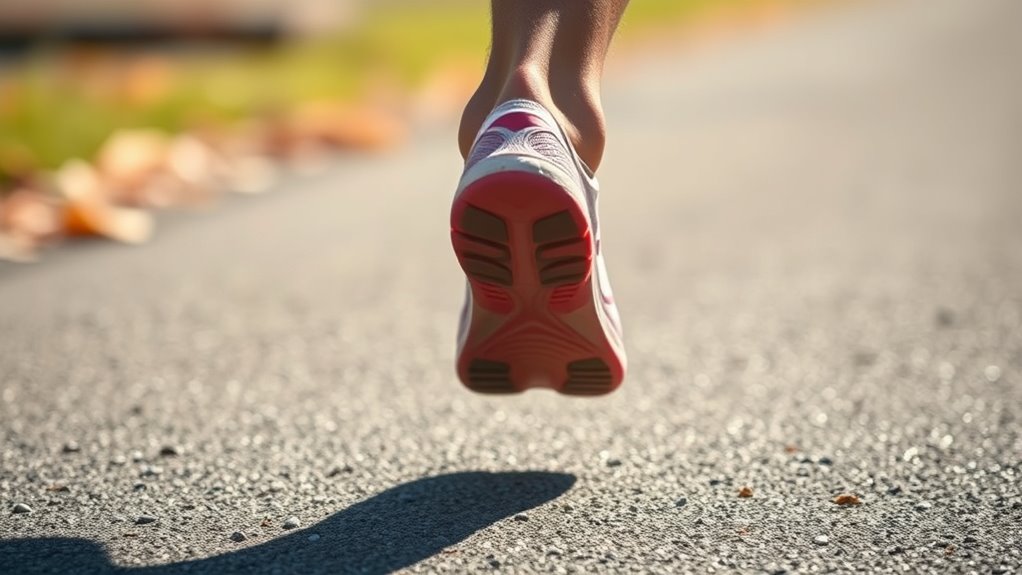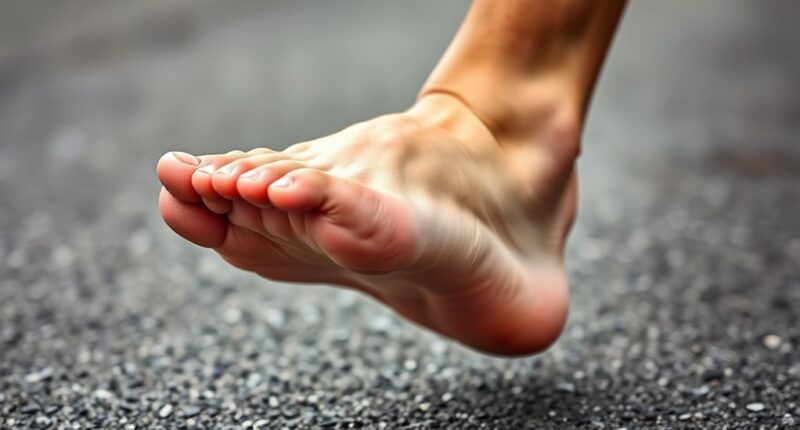Choosing between forefoot, midfoot, or heel strike depends on your running style and goals. Heel strike involves landing on your heel, providing shock absorption but increasing impact forces. Midfoot strikes land with the middle part of your foot, promoting a natural gait and reducing stress. Forefoot strikes land on the ball of your foot, offering cushioning and efficiency, but require more muscular effort. Exploring these patterns further can help optimize your running form and prevent injuries.
Key Takeaways
- Footstrike patterns include heel, midfoot, and forefoot, each affecting running efficiency and injury risk differently.
- Heel strike involves landing on the heel, providing shock absorption but potentially increasing impact forces.
- Midfoot strike distributes impact evenly and promotes a natural gait, reducing stress on specific areas.
- Forefoot strike involves landing on the ball of the foot, often used by sprinters and barefoot runners, requiring muscular effort.
- Choosing and transitioning between patterns should be gradual, with proper footwear and technique to optimize performance and prevent injuries.

Have you ever wondered how your foot hits the ground when you run? The way your foot strikes the ground, known as your footstrike pattern, can influence your running efficiency and your risk of injury. Understanding whether you land on your forefoot, midfoot, or heel can help you optimize your running style to improve running economy and prevent injuries. Each pattern has unique advantages and challenges that you should consider as you analyze your gait.
Discover how your footstrike pattern affects running efficiency and injury risk.
If you tend to land on your heel, you’re likely experiencing a heel strike. This is common among many runners, especially those who run at a steady, relaxed pace. Heel striking can be beneficial because it allows for a natural shock absorption mechanism, but it might also lead to higher impact forces transmitted up your legs. This increased impact can strain your joints and soft tissues over time, raising your injury risk. However, heel striking can sometimes improve running economy if combined with proper footwear and technique, because it minimizes muscular effort in the initial contact phase. To reduce injury risks, focusing on a softer landing and ensuring your shoes provide adequate heel cushioning can be helpful.
Midfoot striking involves landing on the middle part of your foot, with your heel and forefoot touching down almost simultaneously. This pattern tends to distribute impact more evenly across your foot and lower leg, which can enhance injury prevention by decreasing excessive stress on any single part. Midfoot striking often promotes a more natural gait and can improve running economy by reducing braking forces during each stride. It encourages a quicker, more efficient transition from landing to push-off, which makes your running more fluid and less taxing on your muscles and joints. If you notice you naturally land midfoot, maintaining good cadence and supporting foot mechanics can help you maximize these benefits and stay injury-free. Additionally, incorporating appropriate footwear designed for midfoot striking can aid in maintaining proper alignment and comfort.
Forefoot striking, where the ball of your foot hits the ground first, is common among sprinters and those who run barefoot or minimalist. This pattern requires more muscular effort to cushion impact and propel your body forward, which can enhance running economy when performed correctly. However, it also places more stress on your calves and Achilles tendons, increasing the risk of overuse injuries if you’re not conditioned for it. Forefoot striking can be beneficial for reducing impact forces, but it demands strong, flexible calf muscles and proper technique to prevent strain. Progressing gradually into this pattern, with attention to form and footwear support, is essential for injury prevention and maintaining efficiency.
In the end, no single pattern is universally best. Your choice should align with your body mechanics, running goals, and injury history. Paying attention to your footstrike type and making adjustments carefully can lead to better running economy and fewer injuries, helping you run longer and stronger.
Frequently Asked Questions
How Do Footstrike Patterns Affect Long-Term Injury Risk?
Your footstrike pattern impacts your long-term injury risk by influencing overuse injuries and biomechanical efficiency. For example, heel striking may increase stress on knees and hips, raising injury chances, while forefoot striking can strain calves and Achilles tendons. Choosing a pattern that aligns with your biomechanics helps reduce overuse injuries and improves efficiency, making your running safer and more sustainable over time.
Can Footstrike Pattern Change Naturally Over Time?
Think of your footstrike pattern as a river’s course—ever so slightly shifting with time. Yes, it can change naturally through footstrike evolution as your body adapts to new activities, footwear, or injury recovery. Your gait undergoes natural gait adaptation, influenced by strength, flexibility, and habits. These changes happen gradually, like the slow flow of a river, shaping your running style over months or even years.
What Footwear Is Best for Different Footstrike Patterns?
You should choose footwear based on your footstrike pattern to optimize comfort and performance. For forefoot strikers, look for running shoes with cushioned forefoot areas and responsive midsole technology. Heel strikers benefit from shoes with extra heel cushioning and stability features. Midfoot strikers need a neutral shoe with balanced support. Understanding your footstrike pattern helps you select the right running shoe technology, reducing injury risk and enhancing your running experience.
How Do I Determine My Ideal Footstrike Pattern?
To find your ideal footstrike pattern, try barefoot running on soft surfaces to observe how your foot naturally lands. Pay attention to whether you land on your heel, midfoot, or forefoot. Incorporate footwear technology designed for different strikes, like minimalist shoes or cushioned trainers, to support your gait. Gradually experiment and listen to your body to determine which pattern feels most natural and comfortable for you.
Are Certain Footstrike Patterns Better for Marathon Running?
Certain footstrike patterns can enhance your marathon performance, especially when paired with the right shoe technology. Forefoot and midfoot strikes often improve running economy by encouraging a more natural gait and reducing impact forces, which can help you conserve energy over long distances. Heel strikes, while common, may require specialized shoes to minimize injury risk. Ultimately, choose a pattern that feels most efficient and comfortable for your body.
Conclusion
Ultimately, choosing your footstrike pattern isn’t just about preference—it’s about revealing your full running potential. Whether you’re a forefoot, midfoot, or heel striker, each style can turn your run into a smooth, effortless glide—like you’re floating on air. Don’t let the fear of change hold you back; experiment and find what makes you feel unstoppable. After all, mastering your footstrike could be the key to transforming your running game into a legendary adventure!









